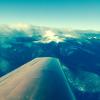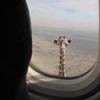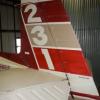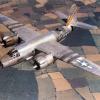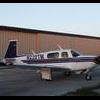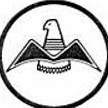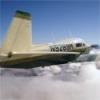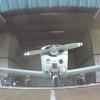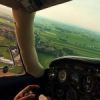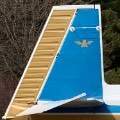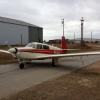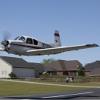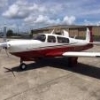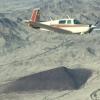Leaderboard
Popular Content
Showing content with the highest reputation on 01/03/2016 in all areas
-
4 points
-
I retired last year after a 35 year career flying corporate jets. I spent 15 of those years flying for a company up in the Pacific NW. Our company was based in Oregon and when it comes to icing, few places will equal what you'll find up in the Pacific NW - with all of the moisture from the ocean and cold air coming down from the north, those Cascades generate as much ice as you'll find anywhere. I've had my share of icing encounters up there and it's nothing that you'd want to mess around with unless you have the proper equipment and the skill and experience to use it properly. One of the problems with icing forecasts is that they're often wrong which means that icing is really where you find it, when you find it. This can lead to guys not taking it seriously after all, how many times can you yell "wolf" before people don't take you seriously? Big mistake. I've also flown in my share of icing in FIKI equipped light aircraft and I have no qualms about doing so; however, the rule about always leaving yourself a way out always applies. Ice is one of those hazards that can and will kill you if it's not respected and dealt with properly. I had a highly experienced friend killed in a FIKI twin Cessna he was flying, it was winter time and he got into some icing over the Cascades. He failed to take action soon enough and it simply overwhelmed him. I think that for a non-FIKI aircraft up in that part of the country, conservative is the only way to go - no amount of ice is acceptable. It's not just the ice that builds up on the wings, it's also the ice that forms on the propeller blades. Ice distorts the airflow and destroys the wing's lift. It does exactly the same thing when it forms on the prop. The resultant loss of thrust only exasperates your problems. (Robert Buck, in his book Weather Flying, discusses flying in ice. It's worth your time to review what he has to say about it.) The bottom line is ice is one of our deadly enemies and must be treated as such which means that there will be times during certain months of the year that a wise and prudent pilot in a non-FIKI airplane will just have to sit it out. Be safe my friend.3 points
-
How much ice? No ice. You owe it to your angel flight pax, who have no idea what they are getting themselves into. You owe it to your airplane, so it flies another day, and to yourself and your family. "If the weather is bad, go IFR, if its really bad, go VFR". This is a statement I take to heart in light GA airplanes without ice protection. Stay clear of the clouds, and you'll be clear of the ice. I can't begin to tell you how awful I felt to have my wife sitting next to me, as out of nowhere clear ice splattered onto the airplane like it was being shot out of a fire hose, running back from the leading edges in long icicles. Stupid, very stupid, a true "NEVER AGAIN" moment... and I did have the brains to only try that with a solid OUT (warm temp below, over the Willamette valley). Over the mountains?? You gotta be kidding me.3 points
-
The flap indicator on my 78 J Decided to stop working. I was able to remove everything from the front with out having to take apart the center console. I started with removing the kick panel on the copilots side. Then I removed the 4 screws from the indicator panel. The glass is separate from the main part with the writing on it. If you put both indicators to the bottom, you can reach around the back with one hand and hold the indacator and use your other hand to slide the plastic up and tilt it sideways and pull it out then you can do the same for the main indicator being careful of the plastic indicators. In my case the plastic indicator was fine It just popped off the wire, more on that later. I used 5 minute 2 part epoxy to glue the indicator back on to the wire it rides up and down on. And then I put it all back together. After it was put back together I noticed It was showing takeoff flap when fully retracted. Doh! Crap I thought I did something wrong so i took it back apart, everything look fine. So I thought me and the hangar fairies would pull the belly panel below the flap motor and hope there was an adjustment. Low and behold there was! And it turned out that it was the cause of my woes from the beginning. The way the wire is held on to the flap actuator is a bit odd. There is a bolt through the actuator with a nut on the other side. Then a washer then a hole in the bolt that the wire is passed through. Then you LOOSEN the nut so it pushes against the washer and wire. Apparently it wasn't tight enough and when it cooled down this year it caused enough resistance in the cable to slowly push the wire farther back each time the flaps were raised until it was so far out of adjustment that when the flaps where lowered it pulled the wire out of the plastic indicator. So I squirted some cleaner up the cable and worked it back and forth a bunch then shot some lube up the cable worked it again, adjusted the cable till the indicator lined up and put it back together. And all is well with the Mooney!2 points
-
I just passed my commercial check ride today! I wish I could say I did it in a Mooney, but it was a Piper Lance PA32RT-300. Loved the climb rate, but it has the glide ratio of a brick. The power off 180 was interesting. Power off, prop back, and a 2000 fpm half spiral to the runway. And the pattern better be really close, like a quarter mile. The turn starts the minute you go to idle. It really made me appreciate my Mooney and how well it glides. Although the Lance was was nice to drop on the runway without the hard Mooney bounce. That said, I would never own one. Anyway, with a turbo 231, I just thought the commercial maneuvers might be too rough on my baby. Time to grab a beer and relax.2 points
-
I did a lot of winter flying in western NY. The clouds there can pick up a lot of moisture from the Great Lakes but can be non-uniform. In other words, some clouds just seem to pick up and hold more moisture than others. That basically meant that icing was unpredictable in location. I flew a number of times at same altitudes as other GA pilots and they reported picking up ice and I had nothing or vice versa. It also meant that icing airmets were issued routinely and covered the whole area. My approach to winter flying when it came to ice was to go below if possible or fly through clouds when I knew the tops were achievable. If the clouds were layered above 3,000 or 4,000 AGL, I typically wouldn't go. Another thing to consider if you needed to shoot an approach. If I knew the destination airport's approach was going to have me in the clouds for a period of time, I would not fly. I learned the best way to deal with it was not to. Sent from my iPad using Tapatalk2 points
-
I don't get everyone's obsession with LED lights. Sure, replacing a landing light to reduce current draw so your old circuit breaker doesn't blow is a good thing. But why replace a perfectly good nav light? The incandescent lights work fine and after 5000 hours of mooney ownership I have replaced two. The incandescent bulbs are not that expensive and I think they are cheaper then the LEDs. Do some of you lay awake at night worrying about getting T-boned at night because of your incandescent nav lights?2 points
-
2 points
-
2 points
-
Believe it or not . . the aviation department at Home Depot has actually lowered the price to $3.98. (Same part # 06635, different packaging now) http://www.homedepot.com/p/MD-Building-Products-3-8-in-x-10-ft-Black-Sponge-Rubber-Foam-Weatherstrip-Tape-06635/100353487?MERCH=REC-_-PIPHorizontal1_rr-_-100355591-_-100353487-_-N2 points
-
Ok...so after several weeks of trouble shooting we found the problem. Believe it or not it was air getting into the fuel system through a poor installation of the Gasalator smashing the O-ring. Thanks to Frank at Chandler Aviation! He did a great jod deducting the problem and isolating variables until we found the root of the problem. I have flown the plane several time and it flies like a dream. Thanks to all on Mooney Space for your thoughts and suggestions. Justin2 points
-
I purchased a non-functional stabilizer and sighthead in Tampa to begin with, and planned to do nothing more than display them. However, I couldn't stop playing with them and then decided to see if I could make them work. I got my stabilizer up and running, but the sighthead had too many parts scavenged. I took the Mooney up to Delaware and purchased another sighthead in better condition. It still needed work, but my experience with the original sighthead helped me get it fixed. There really aren't too many spare parts, and the tolerances are so unbelievably fine that swapping parts is unreliable. I did have to change some parts out on the bomb release mechanism on my functional sighthead using parts from the non-functional one. The bottom line is that to have a working system, it can't be too far gone. Pretty much your only source of spare parts would be another sighthead. To get it all up and running took me about eight months. The U.S. had an earlier bombsight, the Sperry S-1, and they developed an A-5 autopilot for that. The Norden system started out with the Stabilized Bombing Approach Equipment (SBAE) but eventually they went to Honeywell and developed the C-1 autopilot specifically for the Norden. This formed a complete autopilot system allowing the bombardier to pilot the plane using the sight while on the bomb run. I do not have a C-1 autopilot/system. The largest spy ring ever busted, the Duquesne ring, handed over the Norden plans to the Germans early in the war. They were more interested in dive-bombing and did not have four-engine heavy bombers, so they really weren't interested in making a fully stabilized system. They came up with the Carl Zeiss Lotfernrohr 7 bombsight, with later models having gyro stabilization. I think there are many Norden sightheads out there, and quite a bit less stabilizers. Although the supply of stabilizers is smaller, the demand is much less, so the cost is less for the stabilizer in most cases. Prices are all over the place, some on eBay being real bargains and some way over-priced. It seems that people are really obsessed with cosmetics and sights advertised as "still in the crate!" I have seen sights advertised as "new" or "never used" that did not work, and beat up looking things that ran. If all you want is a cosmetic display, you can get sightheads for $2-3,000 and stabilizers for around $1500 or a little more. These things are usually sold "as is" with no guarantee that they will work. I would not buy a system expecting it to work; I would only buy it after physically inspecting it/powering it up. The Mooney helps you go look at them.2 points
-
1 point
-
http://www.knr-inc.com/knr_inc_joomla/shoptalk-articles/25-shoptalk/34-200103-free-play-in-the-mooney-tail Here is a article1 point
-
Gxsrpilot, its so funny how the things we just talked about end up on here - it seems like - the very next day. Ha! I actually ended up pulling an exploded diagram of the tail up so I could see what you were showing me that day Sent from my iPhone using Tapatalk1 point
-
Negative. Perhaps you're referring to the cheap $30 paddles. I have seen the PSA viewed in a dark hangar compared to a an incandescent in the other wing. Same if not slightly larger light foot print and a noticably brighter.1 point
-
Is a whale oil lantern out of the question or is that reserved for the 22nd century?:)1 point
-
I use the actual current for the capacity calculation instead of the time formula given in the Concorde manual. Therefore it should be quite accurate and it is not necessary to have a constant load.1 point
-
If Thomas Edison had invented the LED and we had been using LEDs sense the Wright brothers. When someone In the 21st century finally invented the incandescent light, everybody would be getting rid of their old fashioned LEDs and putting In the new lights...1 point
-
1 point
-
The Li Ion batteries we see today in Teslas, computers, phones, power tools and R/C models, is not the energy storage device that will be used in the aircraft of tomorrow that I'm talking about. Everyone seems to assume it will be a battery of some sort with all the pitfalls of the batteries we have ever known, but it may well be a fuel cell, or maybe even they will finally be able to make a working super capacitor. I don't know, I just know it's coming and I want one. In either case, the Tesla proves my point. The Tesla Model S uses very large batteries that hold a lot of energy. Millions of miles have been reliably driven using them. R/C car batteries fail all the time and don't even come close to the reliability, or longevity of the Tesla batteries. There have been some Tesla failures for sure, but they are far and few in-between and only come to our attention due to the fact that the news media finds a Tesla fire news worthy. Kind of like airplane crashes. The media points out every single crash and so GA airplanes get the reputation as death traps. The media reports every single Tesla fire and so now some people are going "Ah ha!! Told you they were dangerous!" The real truth is, they are the safest car on the road bar none. No one has ever died as of the result of a Tesla fire.1 point
-
Spoken like a true Cheap Bast$&d! I am nominating you for the CB of the month award! Sent from my iPad using Tapatalk1 point
-
Bob, I have had up to 1/4" of rime ice on my bravo with no noticeable degradation in airspeed. But one time, climbing out of Portland I accumulated at least 1/4" of clear ice in approximately 15 seconds - that got my attention. There were no airmets/sigmets for ice and the ADDS icing page ( http://aviationweather.gov/adds/icing ) forecast no ice. In my limited experience I have found what others say to be true: Ice is where you find it! Here is the M20K evaluation that discusses airframe ice - but that's a turbocharged plane: http://www.mooneypilots.com/mapalog/M20K231%20Eval%20Files/M20K231_Eval.htm Dave1 point
-
I build one myself using an Arduino microcontrollet board and lamps as the load. It automatcally switches off when reaching the 10V an stores the whole measurement on a micro SD card for later plotting in Excel Concerning deep discharge you have to consider that the 10V limit is under load. The idle voltage will be higher.1 point
-
I think I would have just put "replaced starboard nav light, verified operation, continue in service"1 point
-
Recently saw some of these installed as NAV lights on the F of another poster here - Even without changing to the recommended clear covers in the pix above, I was surprised at how bright they were at the wingtip across a wide viewing angle - Certainly didn't seem any worse than the incandescent when viewed from behind - I imagine this would be pretty easy to quantify for the FAA?. I have an itch to get these now - just waiting for someone to make them legal...so I can pay 10x as much .1 point
-
1 point
-
I been flying in the Southern California desert 15 years with temp reaching 118 this years. After 10 years of showing up to the office with a red face, sweat stained dress shirts and slacks I bought a ice cooler A/C unit. It helped a lot but it was inconvenient for the amount of flying I did to be running and picking up bags of ice every time I wanted cool air. It is true that when you get to 5000' AGL the air is much cooler but I will usually not turn it off until I'm at 7000' AGL. I was willing to give up the 65lbs of useful load and the 3-5 kts for something that made my flying that much more enjoyable. Now this being an El Niño year I'm sure I will be wishing I had TKS this winter. Although even with TKS, for me flying over the coastal mountain range with mountain obscuration would make it a no go unless I was high enough to glide to clear sky's. Great, now I need A/C, TKS and a parachute!1 point
-
All, As of now we have 37 planes and 53 people attending. 2 people have not replied with the number of people in their party (mikefox and thinwing). We'll probably get a few no-shows but this is a pretty good turnout and I'm hoping the restaurant can support a party this large. I'll call them tomorrow morning. As things always go, a few people probably won't make it for one reason or another but, again, for planning purposes at the restaurant, please post any changes to your status here and/or PM me. As kmyfm20s stated above, right now the weather looks pretty good - let's hope it holds! See you a week from tomorrow, Dave1 point
-
I upgraded my G-model's panel after purchasing it in mid-2015. Upgrades included adding a GMA-340 audio panel and GNS-430W (with 106A indicator). Not quite as glamorous as some of the other major upgrades I see on here, but in my mind it was a very affordable way to add a lot of capability to by '68. The GMA-340 was a major upgrade because the aircraft did not already have an installed 4-place intercom. So the interior needed to be pulled out, back seat jacks installed, the whole works. We took advantage of having the interior out to wire the aircraft for ADS-B out, but I won't be purchasing the transceiver until 2020 gets closer. When all was said and done, the airplane was in the shop for two weeks and the total install cost almost exactly $16,500, inclusive of all parts and labor. About $11,500 of that was the GNS-430W installation, and the remaining $5,000 was for the GMA-340 (majority of that being labor). I was going to simply install a KMA-24 audio panel and Sigtronics intercom, but my avionics technician talked me out if it and I'm glad that he did. Because the majority of the audio panel installation cost is labor, I would have saved less than $700 on the total installation. The GMA-340 is an amazing piece of equipment, and my passengers love the ability to listen to music on their own channel. I also like the fact that an extra $700 got me a brand-new piece of equipment instead of something that's been obsolete for 20 years. Jeff Landon of High Desert Avionics (based at WJF) did the installation, and I'd highly recommend him. This is the second installation I've had him do (the first one being on a club airplane) and I've been very satisfied. I'd be happy to go into any details if anyone is looking to do a similar upgrade1 point
-
1 point
-
generally a couple of headlight bulbs to match the proper draw amperage is the old school load.1 point
-
This scenario possibility is the exact reason I had my AOA with audible warnings in english "getting slow" - in the headset - which come slightly before the standard stall horn. I am sure your CFI was a superb pilot. Everyone can have a bad day. Hopefully we can build some system redundancy to help trap errors.1 point
-
It is a 1967 E originally from Santa Monica California airport. I think it must have been tied outside there for a bit at least, with the salt air. It is original paint and has never had a anti-corrosion treatment. But I think it is all expected in the restoration process, just like restoring a P38 Lightning that is buried in a glacier. You just have to repair and replace as things come up. This is my first annual and I hope this the the worst of them. I learned a lot this month. Carl1 point
-
I have worked with and serviced thousands of Pb-acid batteries over the past 35+yrs, granted these were mostly motorcycle batteries but all lead -acid batteries require the same as far as initial servicing and maintenance. The life of the battery starts with when & how the initial service is performed, adding acid to the correct level and throwing it on the charger until it is fully charged will result in failed battery 1.5 to 2 years down the road. After adding the acid, the battery needs to sit so that the acid fully saturates the plates, most battery manufactures recommend 30 min. or so, I personally wait 3 hrs before hooking it up to a charger. On maintenance free (sealed) batteries I would wait 24hrs before charging, due to the fact all the acid is absorbed into the plates. Do not install the battery before it fully charged as this will shorten the life as well, I have personally seen 7yrs on a properly serviced & maintained battery. Keeping the fluid level up and not allowing the lead plates to be exposed to air is the key to its survival, the water evaporates do to heat, whether it be from charging and/or ambient temperature, so check your water level frequently. The fully charge and “load test” does not drain the battery completely down or it shouldn’t anyway, if it fails the load test generally you recharge and then re-test. Yes it is a pain in the butt to keep a battery serviced correctly and that is why most people just replace them at the first sign of trouble.1 point
-
I use mine all the time, love it! I fly all over the southwest and last summer seemed to have started early and ended late. I would call the factory they would be my first choice for installation. Second would be a MSC that has the most experience. I would estimate that you loose 5 kts with the scoops that hang out there. There are 2 hoses that run the length airplane. It believe it requires removing a couple of rivets to feed the hoses though. I had a mechanic accidentally puncher a hose and they replaced it. It was quite a process charging and adjusting it after that. If anyone is having problems with there units feel free to contact me. I kinda a pro at them. First off is to charge it by pressure not by amount after a complete vacuum on the system. There is a typo in the service manual which states 3.2lbs of r134 it should be 2.3lbs. Also if you have had a puncher like I did or a sudden lose of pressure it require estimating the amount oil in the system which will potentially change your charge levels. If your units not blowing cold air or is spitting ice at you you need to adjust the expansion, this will also affect your charge level. If you are overcharged or have any air in the system it will kick off the high pressure switch and blow warm air.1 point
-
We early GX/STEC owners are not singled out in our upgrade woes. There have been no updates to the software since 401.30 in 2008. http://www.mooney.com/en/sb/M20-307B.pdf No Mooney (other than the new ones coming off the factory line) has the 401.34 software. Therefore no 2005-2008 plane can update to the GTX33ES and have ADSB-out for 2020. Or data logging, the new menus or any other feature since 2008. Lets face it, the software is developed by Garmin (and already done) and then customized by Mooney and Garmin. We have gone over that Garmin owns the STC.. but that software releases + configurations are certified by the OEM via a SB (as above). This is all a question of certification, and we don't know the details of the private agreements of G1000 developers on the levels of testing, hardware combo's etc that would make this a problem. If you have looked at the G1000 system maintenance manual, the key long term problem with G1000 (and all integrated avionics in general) is that if the Vendor/OEM hasn't designed it to happen + released the config for your individual airplane configuration, it doesn't happen. You can't add a TAS unit and just tell the G1000 that ARINC#4 is a TAS in feed. The config must have a selection for the Sky 497. From a technology perspective, we know the GIA63W's work, and I will bet that If you plugged them in today they would run. Same with the GTX33ES. Garmin only writes 1 or 2 versions of the G1000 software.. the magic is in the airframe config files that say.. RS232#4 is a GTX33 software version 5.23 etc. Why is the certification delay (for at least the WAAS/GFC700 units) so long for 401.34? I don't know and Mooney isn't talking. It does seem odd for a business that will make hardware replacements and support airframes for 50 years to delay software updates that are now as essential as any other part of the aircraft. You can see the incredible problems (error) of this system with the GDL88. Garmin's latest and greatest G1000 systems won't talk to it, (i.e. no plane under 10 years old) but you can have full integration with your 20 year old GTN system.1 point
-
1 point
-
I am not sure the family quote makes sense. They found the corrosion made it so it would not make contact until after it was cleaned. So not working was cause of corrosion on the terminals. I would think the no fuel in the tanks was more of an issue.1 point
-
Sorry to hear that. Just a note of correction, this does not appear to be a Grumman "Tiger", but a Grumman "AA-1", which is usually the "Yankee". This is the much smaller two place aircraft and would typically be flown closer to gross weight. They are a Jim Bede design and are known to be quite "sporty". Depending on the year, they are also known to have aggressive stall characteristics. As I recall, early ones were worse than newer. The Tiger is the 4 place and is more docile. Both aircraft are good, but the small one has to be flown carefully at lower speeds and higher weights.1 point
-
Premiere could do it, if you're in the Southeast. Check with any other MSC in your area if you're not As to applicability, I can tell you that flying out of Atlanta it sure is nice to have, and more than just the summer months. And interestingly, in the winter you often get inversions where it's warmer above than below, so with those big windows and horrible little visors in the Ovation and Acclaim, having some cooling air is beneficial. But where is really shines is when you are flying instrument approaches in the summer months, down low, and ATC vectors you around for awhile...you can stay as cool as a cucumber. It does add considerable weight to your W&B...about 80 lbs as I recall. But it doesn't take away from your 120 lb baggage area limit...just adds the 80 to your total aircraft weight.1 point
-
My wife and I went from o69 to KCRQ and back today to visit family. 2h10m there and 2h35m returning. Doing this in a car is impossible! Doing this on a conventional airline would not be pleasant. Doing it in a Mooney - Wow!! Icing on the cake: for the first time my wife said she was really comfortable in the plane with a blanket she brought from home and that the blanket was staying in the plane. She also said "you woke me up on final and I was so comfortable". Wow!! (again). That blanket IS staying in the plane!!!!1 point
-
My neighbor posted this on the VansAirForce web site. I think it's applicable to us as well...... http://www.vansairforce.com/community/showthread.php?t=133053 If the picture doesn't increase your curiosity about what might be lurking in your oil screen, nothing will.1 point
-
YEAH.. The first day of the year and got Snoopy out for a milk run to WLW 25 degrees at 5500 ft 143 knots indicated had snow on our local mountains and lots of snow visible on the Sierras and Mt Shasta was in fine view over a hundred miles away completely covered in snow. on a personal note it's always a bit tough to take flight after there is news of fellow pilots that have suffered accidents. Really glad to get back into the air to remind me what it's all about.1 point
-
Mmmm, I'm pretty sure Vic is talking about the oil screen at the bottom of the oil sump....not the one up on the back of the accessory case on those engines without filters. All the Lycoming engines have this screen, even those with filters. Maybe some of the engine mechanics on here will correct me, but I think Vic is dealing with the "oil pickup screen". For my 'C', pulling that lower screen is a "Boetch of a job" because it is so tight between the bottom of the sump and the firewall complicated by all the carburetor linkages. This is why the screen gets "over-looked" on annuals.1 point
-
Dave, Had better cross me off the list for this get together. I will have to try for the next. Dave1 point
-
Very important. They found an intake leak and that my mags had split timing.1 point
-
I have heard good things about Don's video, but haven't seen it yet. And I, too, had some initial issues handling the heavier nose of the O3 compared to my J. That much engine in front is definitely a recipe for trouble if you don't learn to handle it. So while not a CFI (nor did I stay at a Holiday Inn Express last night) I will tell you what I do. Some of this has already been stated above. Also, get your training and learn what works best for you. But caveats aside: Yes, speed control is critical. It took me awhile to learn how I could slow down the Ovation. But my numbers on final are 2300 RPM and 13" MP, or as needed to maintain correct glide angle. I'm definitely shooting for 75 KTAS or less over the threshold. Another thing, which some people may object to, is leaving the speed brakes out all the way through landing. I've found they do help minimize the float and stabilize the landing. They are certified for take-off in the deployed condition, so don't worry about having to do a go around. Just remember that they're out there. But it's the "feel" on flare and landing that helps me the most, and I picked this up from none other than our Richard Simile, sales guy for Premier down in these parts. He told me that on flare and touchdown, visualize your plane like an eagle or other large bird, where your main landing gear are the talons stretched out and ready to alight on the ground. Use back pressure to keep your nose up, and let those talons (gear) sink slowly into the ground. Keep back pressure up and let the nose gently touch down. That's the feel I shoot for every time. Good luck with it.1 point
-
I recommend my landing video: http://www.donkaye.com/donkaye.com/Perfect_Your_Landings.html Landings are easy when done as I demonstrate. If your speed it correct, then your descent rate is too great if you are bouncing. When you get good, even if you choose to come in a little faster, for example in a night landing with a longer runway, you can grease it on with some power, then at touchdown, reduce power to idle and pop the speed breaks to assist in slo down.1 point
-
Thanks, Really glad to be a Mooney owner. I flew a lot of Pipers but once I flew a Mooney I was hooked. I am an Aerospace engineer and from an Engineering perspective a Mooney is a far superior designed aircraft. I love it. Thanks for the info on the Mag Shop. I need to look up when the mag were last serviced. I will dive into this more. Wish they had Electronic ignition for my Mooney!! Also - Thanks to you all for your input to my problem. It's nice to know there is a community out there that sticks together and shares knowledge and experience.1 point



